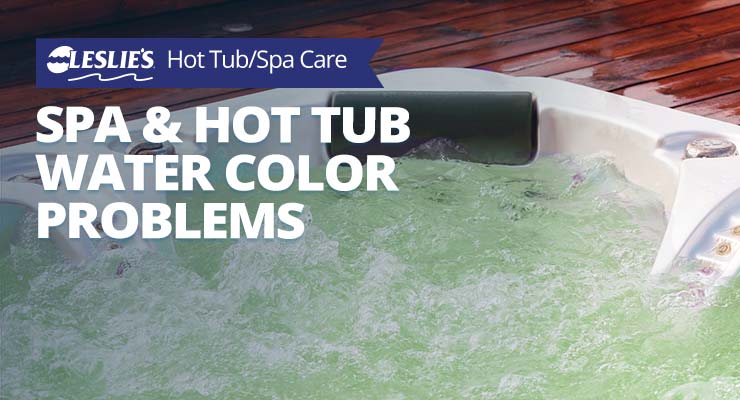
Spa and Hot Tub Water Color Problems
We've all been there before — you lift the spa cover, only to discover a water color other than clear blue. Hot tub water green? It can turn all colors of the rainbow when conditions aren't right: yellow, brown, white, pink, and shades in between.
After you've spent several months (or years!) taking care of your spa, your trained eye can tell right away when something's not right. Maybe it's a bit less sparkly and translucent, and a bit more dull and dirty looking. Or perhaps the water has turned one of these strange spa water colors. One thing is for certain, getting your hot tub back to its pristine state will take some hot tub maintenance, hot tub chemicals, and a thorough check on your hot tub filter.
Today, we'll discuss how to identify and troubleshoot spa water issues so you can get back to clear, sparkling water. It doesn't matter what type or size of hot tub you have, either — even if your tub is as big as a pool. You can still use these tips to fix colored hot tub water.
Hot Tub Water is Green

When your spa water is a shade of green, you may immediately think of algae. If your sanitizer has been low or your filter cartridge is dirty, algae very well could be the issue. Touch the sides of the spa. If it feels slimy, you can bet you have a small algae bloom on your hands. Algae can even grow under a spa cover in the dark, hot water, so it's important to treat the problem right away.
To treat a hot tub for algae, check and balance pH and Total Alkalinity. Then use a chlorine shock treatment to boost sanitizer levels. After filtering out dead algae, we recommended replacing the old spa cartridge with a new one. If you have continuous problems with algae in your hot tub, make sure your water is properly balanced, your sanitizer levels are where they should be, and you're circulating the spa enough. If needed, use a non-metallic algaecide to help prevent future blooms.
In some cases, green hues in hot tub water can also be caused by copper. There are many ways copper can enter the hot tub. Sometimes it comes from copper pipes carrying fill water, or it may be present in your water source. It's also introduced through copper heat exchangers used in gas-fired spa heaters, or it can come from using copper pool algaecide in a spa (which is not recommended). This is the same copper that turns a swimmer's hair green. When copper is the culprit, the hot tub water will appear clear and bright green in color, but without slime on the surfaces. Control copper in your hot tub water with a product like Metal Gon, Spa Metal Free, or CuLator packets.
Hot Tub Water is Yellow

Yellow algae is a particularly resistant type of algae that can exist in dark, heated water, even in the presence of normal bromine or chlorine levels. It seeks out small, out-of-the-way crevices to hide and multiply. When in full bloom, it will deposit itself in sheets across spa surfaces.
Treatment for yellow algae is to use a very high level of chlorine spa shock. Balance the water first, and turn off the heater before shocking the spa. Allow the water to circulate for several hours with the cover removed. If the Free Available Chlorine or Bromine level drops to 0 ppm within 24 hours, shock the spa again until it holds sanitizer levels. After this shock treatment, drain and scrub the spa, bleach and wash the spa cover, and replace the hot tub filter with a new cartridge.
Yellow hot tub water can also come from an excess of pollen in the springtime. This is especially true if you have left the spa cover off for some time.
Iron oxides in well water can also impart a yellowish color to the water, and is most noticeable if the spa turns yellow after shocking. If you are on a well water system, use a metal control product like Spa Metal Free.
Finally, if your bromine level is extremely high, the water can take on a yellow-red color, especially in the presence of low pH levels. Don't enter a spa if the bromine residual is over 5 ppm.
Hot Tub Water is Brown

Brown water is not the most appealing hot tub water color. If your spa has suddenly turned brown, much like the color of tea, you can usually find the problem to be high levels of minerals — namely iron oxide. This may occur within hours after shocking the spa or making big pH adjustments. A new hot tub filter cartridge should remove some of it, but to clear it up faster, you can force it back into solution with a sequestering agent like Spa Metal Free.
Brown spa water also happens because of contaminated fill water. During dry, hot periods, some municipal water supplies begin scraping the bottom of the barrel, so to speak. This can add a lot of particulate matter to the water supply. You can combat this by using a pre-filter on your garden hose when filling the spa. This simple tool will remove certain microscopic particles from your fill water.
Hot Tub Water is White

Milky hot tub water, which is so cloudy that the water appears white, can come from mMilky hot tub water, which is so cloudy that the water appears white, can come from many causes. High Calcium Hardness or Total Alkalinity, ineffective filtering or pumping, or air in the system causing micro-bubbles — all of these can make hot tub water appear cloudy white. Contaminants from body lotions, cosmetics, and hair products can also change the water color from clear blue to white. If your spa has cloudy water, take a look at our troubleshooting blog post that goes over the 10 reasons why, as well as how to fix it.
White hot tub water can also be infected with white mold, a type of bacteria that grows in small clumps anWhite hot tub water can also be infected with white mold, a type of bacteria that grows in small clumps and clusters. In situations where hot tub maintenance is not routine, this type of slime can be difficult to remove. However, it can be treated effectively by superchlorinating the water to 30 ppm, running the spa for several hours, and then draining the water. Before draining, use a biofilm remover like Jet Clean to clear out the pipes. Replace the spa filter, and rinse all removable items like spa pillows, nets, baskets, and thermometers in a strong bleach solution.
Hot Tub Water is Pink

Pink algae is a close cousin of white water mold discussed above. Surprisingly, it's not actually an algae, it's a form of bacteria. However, it still displays characteristics of an algae. Pink is not a common color for spa water. In fact, pink algae won't actually color the spa water pink, except in very mature colonies. Treatment for pink algae is similar to white mold above. It's not easy to eradicate, as it is able to tuck away cells that are difficult to reach. However, you can eliminate it by hitting it hard with shock (over 30 ppm). Also use an enzymatic purge product to clean the lines and crevices. Be sure to replace your spa filter, and soak all spa items in a strong bleach solution before refilling with water.
Don't let colored hot tub water get you down! There's always a solution, no matter what color the water. In most cases, proper water balance and adequate sanitizer levels are enough to keep your water clean and crystal clear. But if you find yourself struggling with discolored hot tub water, we can help! Bring a water sample to your local Leslie's for a free 10-point professional water test. With the right hot tub maintenance, chemicals, and filters, we can get your hot tub back to sparkly and blue in no time!